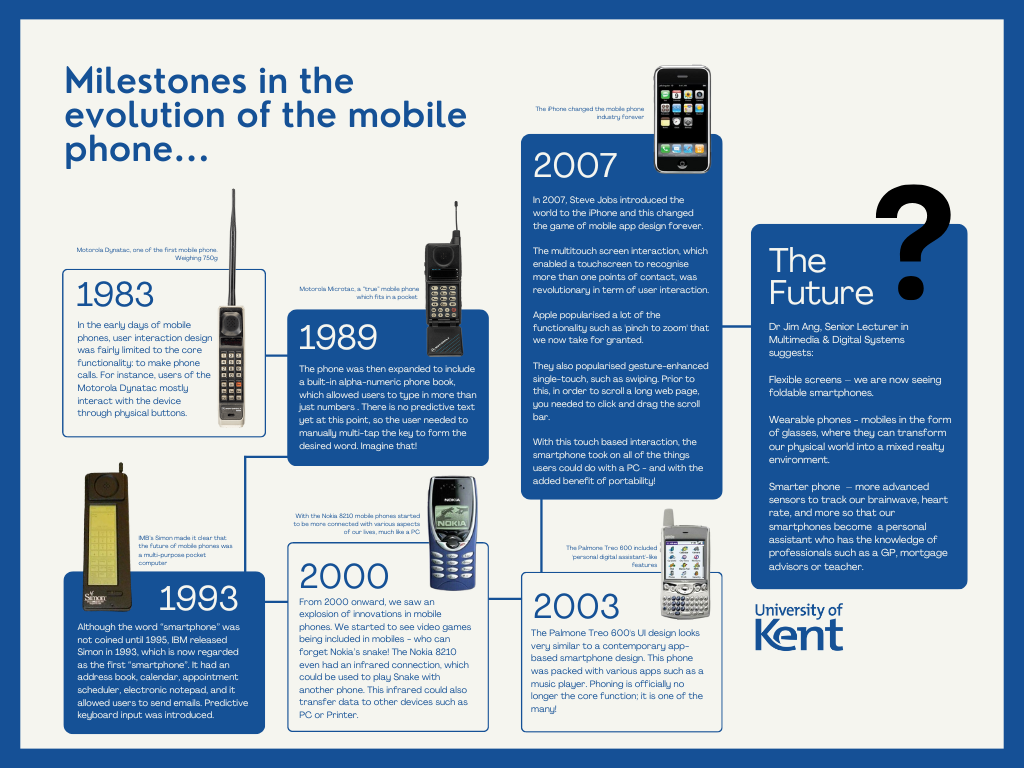Phones at 50: Expert explains how mobiles became more than just a phone

Mobile phones transformed how we communicate, work, learn and entertain – what started off as a portable telephone device 50 years ago has evolved into what is arguably one of the most important pieces of technology today. The average person spends 3 hours and 15 minutes on their phones every day, checking them around about 58 times a day – or every 4 minutes.
To explain how mobiles evolved from telephone devices to an industry that is estimated to be worth USD 792.51 billion by 2029, Dr Jim Ang, Senior Lecturer in Multimedia & Digital Systems at the University of Kent, says:
‘It is no surprise that we spend so much time on our phones. Our smartphones have become an extension of human cognition; the mobile has enabled us to extend our memory with the storage of hundreds, thousands or even millions of phone numbers, and it has extended our knowledge with easy access to the web.
‘Thanks to mobile phones, we can connect not just with our close friends and family, but pretty much anyone around the world. We have access to almost unlimited knowledge whenever we are, and we can have the world map at our fingertips to help us navigate unfamiliar cities. There are apps to track our lifestyle, sleep and mood – we can now have therapy via smartphones, practice mindfulness, and have a personal trainer in our pocket! Our phones keep us entertained: with music, TV and games just a click away. A huge part of our daily lives is now facilitated by mobile technology.
‘Aside from the convenience that mobiles bring to our lives, the design of modern-day phones also keep us coming back for more – notification systems, hyper-personalised content driven by AI algorithms to filter out information, and endless streams of news, keep us hooked.
‘But how did our smartphones become so significant? The main driver behind the ever-so-powerful smartphone is the miniaturisation of electronics, which led to the number of transistors on a chip doubling every two years (Moore’s law). This meant computer devices started shrinking in physical size whilst getting more powerful, computationally. The smartphone in our pocket today is millions of times more powerful than the Apollo 11 guidance computer which sent humans to the moon.
‘Other key technology which powered the smartphone revolution is long-term evolution (LTE). Given that we are doing so much more than just making phone calls, we need technology which can send and receive high amount of data at high speed. LTE provides increased network capacity and speed for mobiles.
‘Additionally, multi-touch screen and gesture-based interactions, which make using smartphones so much more intuitive and easier to use, allowed for more complex apps to be built. Today, the touchscreen to a smartphone is akin to keyboard-mouse to a PC.
‘Camera technology, together with computer vision algorithm, algorithm which is designed to recognise and understand pictures, is another key technology which is integral to smartphones. A camera is not just a nice side-feature. It enabled new forms of interactions too, such as QR code, and it played a significant role in improving the security of the phone – especially for banking and healthcare apps, where security is paramount – through face unlocking.
‘Considering how the phone has evolved so much in such a short space of time, many predictions have been made as to what the mobile of the future might look like. Flexible and foldable screens are to be expected – and this could pave the way for more a more human-integrated phones, such as a screen that mounts directly onto our arm.
‘Other types of wearable phones could be on the horizon too; mobile glasses could transform the physical world into a mixed reality environment. These glasses could recognise human faces and superimpose names next to them, removing the need to remember lots of names in situations like business conferences. Information screens at train stations in the future could just be a blank canvas, where personalised tarin information is superimposed onto it via our glasses.
‘Finally, mobiles are set to become smarter. We can anticipate more advanced sensors to track our bodies and brainwaves, with smarter AI to better understand us, keep us healthier and provide much more personalised help and information. With this type of technology built into our mobiles, we could have a personal assistant who has the knowledge of a GP, a mortgage advisor and a teacher all at our fingertips.’
Dr Jim Ang is a Senior Lecturer in Multimedia and Digital Systems in the School of Computing, University of Kent. Dr Ang’s main research interest lie in the general area of HCI (human-computer interaction) with an emphasis on digital health.




